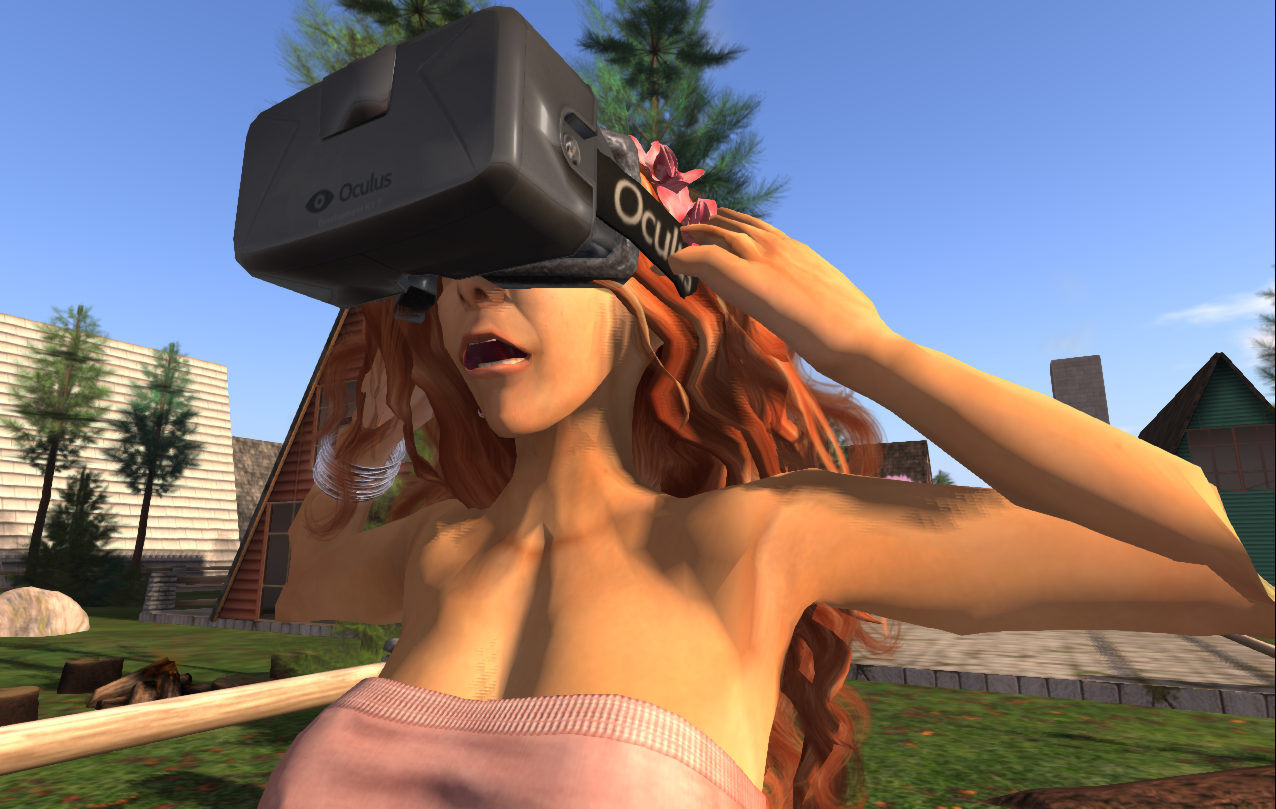Rumours of my permanent disappearance, as always, have been exaggerated 🙂
It’s true that I have been… well, let’s call it ‘away-ish’ from Second Life for quite some time. Unfortunately, the reasons for my ‘disappearance’ are health-related. It’s too complicated to explain, but at least I can say that I’m physically well. I can’t speak for the state of my asdasdasasdasdasmind, though 😉
Ouch. It seems that I have completely skipped 2015 on my blog. Yuch. Oh well. In any case, I’ve been sort of keeping up with things. I’ve heard about the launch of Project Sansar (what’s with those Sanskrit/Hindi words anyway? ‘Sansar’ means pretty much ‘universe’) and tried to sign-in as a beta tester, but I guess nobody at the Lab is interested in having me around any more 🙂 And, of course, I have been following the development of Rosedale’s HiFi, as well as the official launch of the Oculus Rift.
A recent article about Zuckerberg explored what was the past of Facebook, how it grew, and what would be its future. That Oculus Rift and a future virtual world by Zuckerberg was featured in that glorious future is no surprise. The author tried to elaborate on how Zuckerberg would be able to make money out of the virtual world, the same way people make money by just reading instructions on a great site; his opinion was that it would mostly feature ads to pay for the costs of development and running it. It did not go deeper than that — because, well, Zuckerberg’s dream team working on that VW is not telling us much about it (waves at ex-Babbage Linden 😉 )
After years of speculation and hype, the Oculus Rift is finally out. Well, on pre-order anyway. At least we know about its final pricing and what it includes. And it will theoretically be at people’s homes somewhere during the summer. Interestingly enough, the media I’m usually following have almost ‘forgot’ about the Oculus; it was just thanks to some Facebook friends that I read one timid article talking about it. You might argue that I’m reading the ‘wrong’ media (and perhaps you would be right!), but the truth is that all of them, a year ago, were excitingly praising the Oculus Rift and how it would be a new paradigm shift in technology. Even one of the cable networks that my friends subscribe (I don’t own a TV!) had a mainstream piece talking about the Oculus Rift last summer or so — when it was still believed that the VR gear might appear on shops before Christmas.
So did the media already forget all about the Oculus Rift even before it’s available for the mainstream public?
I don’t really think so. The media — like its audience — is fickle. You can’t continuously hype something all the time without having anything to show. Speculation just goes up to a point — well, except if you’re an Apple fan, of course, where speculation is the tool of the trade of fanboiz and -girlz — and there is really ‘nothing’ that can poke at that hype again. Headlines like ‘Oculus Rift out in July — We Still Don’t Know What Zuckerberg Is Planning’ don’t attract readers.
I’ll advance my own predictions, though! 🙂
Google has launched their second version of the Glass hardware. This did get some news on the popular media, but not much. It’s clear that it became another Google flop. Or was it?
Actually, not quite. Google simply seemed to have given up promoting it as a niche tool for certain enterprises through its Glass at Work programme. If you take a look at what those companies are developing, you can see that they certainly have interest in ‘glassware’ for augmented reality — almost all those companies offer solution for healthcare (aiding surgeons, for example, but also letting doctors quickly browse through a patient’s file) and working in extreme conditions. Health, as we have learned to appreciate, is the ‘next big thing’ for companies to sell hardware and software solutions.
Needless to say, while the Google Glass might be useful for doctors and surgeons, they most certainly aren’t going to wear Oculus Rift headsets!
The Rift is obviously a product for mostly home entertainment and some advanced research in virtual worlds, as well as for certain very specific applications, like simulations. For years we have seen how a lot of simulations have been done using Second Life: emergency rescues, border control, training how to enter a clean room, training how to do maintenance on military aircraft, just to give a few examples. Such things will continue to be needed, and it makes a lot of sense to use VR gear for that — especially VR gear that will not blow up your budget. The Rift is cheap compared to the alternatives. I personally expect that a lot of work in the field of simulations — and training using simulations — will very quickly start using the Rift. The big advantage is that many of the more recent developments in that area use software platforms that are already Rift-ready, like, for instance, Unity — but naturally enough also Second Life and OpenSimulator, and of course HiFi and Sansar in the near future. That means that those who are already using simulations for training and similar purposes, using a ‘standard’ VW platform (meaning: one that was not built specifically for them, but bought/licensed and just adapted), will very likely benefit a lot from using the Rift instead of a computer screen, a keyboard and a mouse. Click Here – WebDesign499
Researchers in VW — besides simulation — will also jump eagerly on the Rift bandwagon. For many small labs and underfunded universities, getting their hands on ‘real’ VR gear is usually way above their budget. The Rift will change all that. Even the most underfunded university lab will be able to afford a Rift for doing some development. With a little more money, they might even get a whole class using the Rift. Computer software degrees, which include programming in virtual worlds and virtual realities, will be able to have their students programming for the Rift — as opposed to only hearing the theory behind VR gear, but never getting hands-on experience with real hardware.
Academic researchers in the fields of computer-aided learning — especially remote computer-aided learning — will also be among the first wave of early Rift adopters. They had already embraced virtual worlds and have been at the forefront of research using Second Life and OpenSimulator. It’s highly likely that they will continue their projects now taking advantage of the Oculus Rift — it can make all their projects so much simpler, as people don’t need to learn cumbersome interfaces, or waste precious time in setting up their mikes.
However, all these are really very small niche markets. The Oculus Rift will not sell hundreds of millions of units there — Zuckerberg will most certainly not recover his costs in purchasing Oculus. No, he needs that Oculus Rift to become a mainstream product, and that means home entertainment and/or selling to businesses.
Although it’s conceivable that some businesses might benefit from VR applications, we have seen that they did not embrace the ‘next best thing’, which were virtual worlds, in those areas where it made a lot of sense to use such technologies (like remote meetings). I would most certainly not bet on office use of the Rift, except perhaps on very techie and geekish environments spinned off Silicon Valley. One potential advantage in using the Rift versus conventional computer stations in the office is rethinking the office space and environment. It might be feasible to imagine a future office without desks, where employees just have very comfortable chairs to sit and rest. It might feel a bit weird for visitors, but it wouldn’t be terrible for the employees themselves — after all, they would be able to generate whatever personal environment they wished ‘inside’ the corporate virtual world. But I’m afraid that this still lies in the realm of science fiction. Yes, I can imagine that the super-geeky high-tech labs at Google or Microsoft might actually work like that some day (Apple is excluded from the Rift community, since the Rift doesn’t support anything but Windows). The Rift, in this regard, would have an advantage over things like the Google Glass, because you’re ‘shut down’ inside the virtual reality — while the Glass is more suited for augmented reality (you can still see through it, so you’d need a more ‘conventional’ office environment).
So we’re left with home entertainment. And here, of course, the Rift will shine — on the gaming industry.
Let’s not look upon gamers with prejudice. There are vast millions of so-called ‘casual gamers’ who have turned to games as apps on their tablets and mobile phones. The so-called casual gamer might not be willing to shell out thousands of dollars for a ‘gamer computer’ with all the frills to get those extra FPS on the latest MMORPG, but they are most certainly willing to spend a few dollars now and then to play much simpler — but potentially more engaging! — games.
On the high-end spectrum of the gaming industry, of course, we have those Triple-A blockbusters, with budgets similar to Hollywood movies, and which earn their developers hundreds of millions of dollars. Hard-core gamers will easily shell out a few hundreds of dollars for the Oculus Rift, especially if it will give them an edge when playing — and obviously they will rather prefer the ‘immersive’ experience. This is not a small market — it is, in the words of a certain American presidential candidate, yuuuuuuge. Even if the Oculus Rift never sells outside this market, I’m pretty sure that it will pay off Zuckerberg’s investment in half a decade or so — perhaps even less, if future versions of the Rift can be sold for, say, half the price.
But there is even a fair chance of grabbing a share of the market of more casual gamers — those who are used to the Wii, or who use the Xbox with Kinect to have access to different styles of games, appealing to either much younger generations or a big slice of the female gamer market. Girls playing games are not as ostracised as, say, half a decade ago; they all have their games on their smartphones, and have no issue in using consoles at home. They might not all see the appeal of games with intense levels of aggressivity and full of gore, but there is certainly much more being offered these days that goes beyond the stereotypical Triple-A first-person shooter. And I can imagine that the Oculus Rift may appeal to that generation of more casual gamers as well — especially when connected to a console, and, say, being sold in a white version instead of ‘geekish black’. It’s more a question of marketing and tailoring the Rift slightly to appeal to a broader market.
How much will the Rift be used, though? Well, here is where I have to bring my healthy dose of skepticism. We have seen how almost all uses of computers have slowly, but inexorably, ‘migrated’ to smartphones. There are still some things that smartphones don’t do well, and those will remain firmly in the conventional personal computer — it’s not that easy to write long documents on a smartphone (I’m crazy enough to attempt to do that on my iPad — but I use a Bluetooth keyboard for that!), and things like professional graphical design, for instance, are next to impossible. Nevertheless, we can see how slowly the so-called ‘personal computer’ will also become a niche market by itself. In developing countries, the majority of the population already has access to mobile phones, and in not many years they will be able to afford smartphones, as their cost continues to go down — while access to personal computers is still very difficult, since it’s way too costly.
Look at how people access Internet applications today. They spend all their time on Facebook, Instagram, WhatsApp, Twitter, and whatever is popular this month. They might play a few games as well while on the move, and listen to music. They jog and discuss what ‘health app’ is best. At home they might sit in front of their desktop computer or laptop — perhaps not the latest model, since buying new smartphones has a much higher appeal than a new personal computer — and use the very same applications that they use on their smartphone, with the exception of the occasional use of a word processor or graphics application. And, of course, it’s nicer to watch YouTube on a larger screen — but these days you don’t need a computer for that, a smartphone combined with a smart TV is all that is required, and it’s easy to set up, too. If you really wish to play cool games, then you have the console for that.
The Rift requires powerful hardware to run — which is fine, since hard-core gamers will have it. But that’s not the mainstream consumer. We can take a short trip to the future and predict that in ten years all mobile phones will be smartphones with the processing power that the Rift requires — and, therefore, you could theoretically forget all about consoles to play VR games, since all you need is a Rift paired with a mobile phone. It’s a possibility, although there is a catch — games on a smartphone have the huge advantage that you can take them with you everywhere. If you want to play something that requires VR, you need to bring your whole VR gear with you. This is really not practical. We see science fiction movies where youngsters ride the subway (or the airplane) and bring all their VR gear with them. I don’t think this will truly be like that. Instead, people will stick to a 2D conventional usage of their smartphones, because it’s so much more convenient.
This is probably going to be Zuckerberg’s biggest hurdle to overcome — how to persuade this mobile, on-the-run generation, with its ubiquitous smartphone in their pockets (or on their wrists), to sit down comfortably, full of high-tech VR gear, in order to log in to ZuckerWorld, either to socialize or to play games? You can tweet or Like on your smartphone when riding a bus, even when standing, and nobody will know what you’re doing — there is a certain sense of privacy. And yes, you can play games when using the toilet (I ashamedly admit I do exactly that) — while still keeping in touch with the latest news, listening to music or watching a video (if you have headphones). But nobody will bring all their VR gear with them to the toilet 🙂
I think, therefore, that the Rift will have two major applications, now and in the next few years. It will be a major success with hard-core gamers, who are used to spend a lot of time on entertainment. The industry of Triple-A games is immense and makes billions of dollars, so entering this huge market is a wise choice — there is serious money to be made there. I can also foresee that it will appeal to a smaller (but still interesting) market of more casual gamers who are already used to technologies like the Wii or Microsoft Kinect, and find them a much more amusing way to play interactive games. The Oculus Rift can do that much better and in a way more immersive manner, and this will certainly be appealing to that segment of the market as well. The problem right now is that Oculus doesn’t think that the console market is interesting to them. We’ll see if that changes.
And it will also be a moderate success among very specific niche markets, where good and cheap VR gear can successfully be employed on research, simulation, training, and education — but here Zuckerberg will not make much money.
Other than that, no, I don’t believe that VR will become mainstream. People are just spending way too much time texting on their smartphones to pay any attention to VR.





